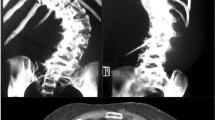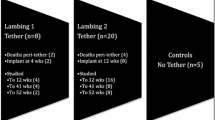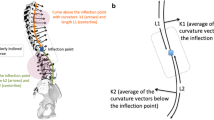Abstract
Scoliosis, especially idiopathic scoliosis, is a complex three-dimensional deformity of the spine in which the vertebral deformities are known, cuneal deformation being the most commonly known deformity but not the only one. We report here data concerning these specific vertebral deformities in chickens. A pinealectomy was performed in a controlled series of animal experiments. This technique induces progressive scoliosis in more than 80% of chickens, with the advantage of being non-aggressive to the spine. Vertebrae included in major thoracolumbar curves were observed in 17 chickens (11 male, 6 female) and classified into three types of vertebral deformities. Vertebral deformity type 1 is characterized by three-dimensional corporeal torsion, which defines the horizontal disorientation of the curve. Vertebral deformities type 2 and 3 define lateral imbalance in the election plane of the curve. Radiological and anatomical data collected throughout the progression of the scoliosis indicate that there is a correlation between structural vertebral deformities and growth/ maturation patterns. We compare our results with those reported in literature concerning human idiopathic scoliosis and experimental animal scoliosis.
Similar content being viewed by others
References
Barrios C (1993) Experimental thoraco-lumbar spinal stenosis induced in pigs by epiphysiodesis of the neurocentral growth cartilage. Presented at the Sixth General Meeting of SIROT. Seoul
Beguiristain JL, De Salis J, Oriaifo A, Canadell J (1980) Experimental scoliosis by epiphysiodesis in pigs. Int Orthop 3:317–321
Byrd JA (1988) Current theories on the etiology of idiopathic scoliosis, Clin Orthop Rel Res 229:114–119
Deacon P, Flood BM, Dickson RA (1984) Idiopathic scoliosis in three dimensions. A radiographic and morphometric analysis. J Bone Joint Surg [Br] 66:509–512
Dickson RA (1985) Aetiology of idiopathic spinal deformities. Arch Dis Child 60:508–511
Dickson RA, Lawton JO, Archer IA, Butt WP (1984) The pathogenesis of idiopathic scoliosis. Biplanar spinar asymmetry. J Bone Joint Surg [Br] 66: 8–15
Duff SRI (1988) Abnormalities in the axial skeleton of broiler breeding fowl. Avian Pathol 17:239–258
Karaharju EO (1967) Deformation of vertebrae in experimental scoliosis. Acta Orthop Scand [Suppl] 105:9–79
Knutsson F (1963) A contribution to the discussion of the biological cause of idiopathic scoliosis. Acta Orthop Scand 33:98
Lawton JO, Dickson RA (1986) The experimental basis of idiopathic scoliosis. Clin Orthop Rel Res 210:9–17
Machida M, Dubousset J, Imamura Y, et al (1993) An experimental study in chickens for the pathogenesis of idiopathic scoliosis. Spine 18:1609–1615
Mochida J, Benson DR, Abbott U, Rucker RB (1993) Neuromorphometric changes in the ventral spinal roots in a scoliotic animal. Spine 18:350–355
Moe JH, Bradford DS, Lonstein JE, Winter RB (1978) Scoliosis and other spinal deformities. Saunders, Philadelphia, pp 56–65, 81–130
Ottander HG (1963) Experimental progressive scoliosis in a pig. Acta Orthop Scand 33:91–97
Perdriolle R, Vidal J (1985) Thoracic idiopathic scoliosis curve evolution and prognosis. Spine 10:785–791
Perdriolle R, Becchetti S, Vidal J, Lopez P (1993) Mechanical process and growth cartilages. Essential factors in the progression of scoliosis. Spine 18:343–349
Rigdon RH, Mack J (1968) Spontaneous occurrence of scoliosis in the chicken. Avian Dis 12:530–543
Riggins RS, Abbott UK, Ashmore CR, et al. (1977) Scoliosis in chickens. J Bone Joint Surg [Am] 59:1020–1026
Roaf R (1966) The basic anatomy of scoliosis. J Bone Joint Surg [Br] 48: 786–792
Sarwark JF, Dabney KW, Salzman SK et al (1988) Experimental scoliosis in the rat. Spine 13:466–471
Stagnara P (1985) Les déformations du rachis scolioses, cyphoses et lordoses. Masson, Paris, pp 84–90, 124–142, 154–159, 160–172, 173–183
Thillard MJ (1959) déformations de la colonne vertébrale consécutives à l'épiphysectomie chez le poussin. C R Assoc Anat 46:22–26
Vital JM, Beguiristain JL, Algara C, et al (1989) The neurocentral vertebral cartilage: anatomy, physiology, and physiopathology. Radiol Anat 11:323–328
Yamada K, Yamamoto H, Nakagawa Y et al (1984) Etiology of idiopathic scoliosis. Clin Orthop Rel Res 184: 50–57
White AA, Panjabi MM (1990) Clinical biomechanics of the spine, 2nd edn. Lippincott, Philadelphia, pp 128–168
Author information
Authors and Affiliations
Rights and permissions
About this article
Cite this article
Coillard, C., Rivard, C.H. Vertebral deformities and scoliosis. Eur Spine J 5, 91–100 (1996). https://doi.org/10.1007/BF00298387
Received:
Revised:
Accepted:
Issue Date:
DOI: https://doi.org/10.1007/BF00298387




